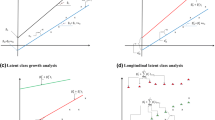Abstract
Gomez and Lagakos (1994) propose a nonparametric method for estimating the distribution of a survival time when the origin and end points defining the survival time suffer interval-censoring and right-censoring, respectively. In some situations, the end point also suffers interval-censoring as well as truncation. In this paper, we consider this general situation and propose a two-step estimation procedure for the estimation of the distribution of a survival time based on doubly interval-censored and truncated data. The proposed method generalizes the methods proposed by DeGruttola and Lagakos (1989) and Sun (1995) and is more efficient than that given in Gomez and Lagakos (1994). The approach is based on self-consistency equations. The method is illustrated by an analysis of an AIDS cohort study.
Similar content being viewed by others
References
V. DeGruttola and S. W. Lagakos, “Analysis of doubly-censored survival data, with application to AIDS,” Biometrics vol. 45, pp. 1–12, 1989.
H. Frydman, “Semiparametric estimation in a three-state duration-dependent Markov model from interval-censored observations with application to AIDS data,” Biometrics vol. 51, pp. 502–511, 1995.
G. Gomez and S. W. Lagakos, “Estimation of the infection time and latency distribution of AIDS with doubly censored data,” Biometrics vol. 50, pp. 204–212, 1994.
J. D. Kalbfleisch and J. F. Lawless, “Regression models for right truncated data, with applications to AIDS incubation times and reporting lags,” Statistica Sinica vol. 1, pp. 19–32, 1991.
M.Y. Kim, V. G. DeGruttola, and S.W. Lagakos, “Analyzing doubly censored data with covariates, with application to AIDS,” Biometrics vol. 49, pp. 13–22, 1993.
S.W. Lagakos, L.M. Barraj, and V. DeGruttola, “Nonparametric analysis of truncated survival data, with application to AIDS,” Biometrika vol. 75, pp. 515–523, 1988.
J. Sun, “Empirical estimation of a distribution function with truncated and doubly interval-censored data and its application to AIDS studies,” Biometrics vol. 51, pp. 1096–1104, 1995.
X. M. Tu, “Nonparametric estimation of survival distributions with censored initiating time, and censored and truncated terminating time: application to transfusion data for acquired immune deficiency syndrome,” Appl. Statist. vol. 44, pp. 3–16, 1995.
B.W. Turnbull, “The empirical distribution function with arbitrarily grouped censored and truncated data,” Journal of the Royal Statistical Society, Series B vol. 38, pp. 290–295, 1976.
Author information
Authors and Affiliations
Rights and permissions
About this article
Cite this article
Sun, J. Self-Consistency Estimation of Distributions Based on Truncated and Doubly Censored Survival Data with Applications to AIDS Cohort Studies. Lifetime Data Anal 3, 305–313 (1997). https://doi.org/10.1023/A:1009609227969
Issue Date:
DOI: https://doi.org/10.1023/A:1009609227969




